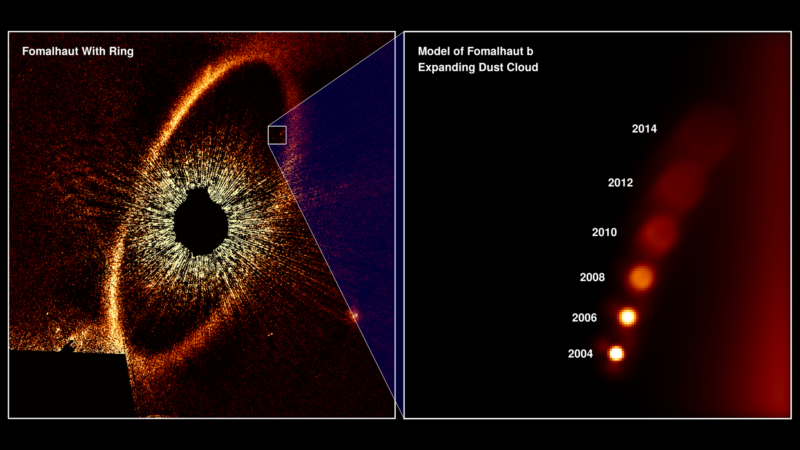Now you see it … –
What we thought was a planet appears to be gradually fading from view.
John Timmer – Apr , : (UTC UTC)
How could astronomers have identified a planet that did not exist? Well, it really looked like it did. Back in , when scientists first announced its discovery , the planet Fomalhaut b seemed to be very much there. Consecutive images taken a couple of years apart appeared to show it orbiting, and its orbit took it through a disk of dust and frozen material that is exactly where we’d expect planet formation to take place. So, at first glance, everything looks good.  But problems became apparent pretty quickly. For one, planets have sufficient gravity to create gaps in any disks of material that they orbit within. But the disk at Fomalhaut b appears to be remarkably unperturbed by what seems to be a giant planet within it.
But problems became apparent pretty quickly. For one, planets have sufficient gravity to create gaps in any disks of material that they orbit within. But the disk at Fomalhaut b appears to be remarkably unperturbed by what seems to be a giant planet within it.
Combined, these facts limit the possible size of the planet to smaller than Jupiter. Further observations took the limit down to near Earth-sized, which is basically incompatible with the amount of light we see from it. So, people started considering alternative ideas about what Fomalhaut b might be, including a smaller planet with large rings or even simply a large cloud of dust generated by local events in the ring.
 The first issue was with the orbital solutions. Based on Fomalhaut b’s position in the earliest few images, researchers were able to calculate its orbit and predict where it should be in future images. And, in later images, it was close to where it was predicted to be. But differences existed and got larger over time. By the last image they had where Fomalhaut b was visible, it had deviated significantly from its predicted orbit. When the researchers tried to figure out its actual orbit, they discovered it was unstable — Fomalhaut b was apparently leaving the system.
The first issue was with the orbital solutions. Based on Fomalhaut b’s position in the earliest few images, researchers were able to calculate its orbit and predict where it should be in future images. And, in later images, it was close to where it was predicted to be. But differences existed and got larger over time. By the last image they had where Fomalhaut b was visible, it had deviated significantly from its predicted orbit. When the researchers tried to figure out its actual orbit, they discovered it was unstable — Fomalhaut b was apparently leaving the system.
Obviously, there are lots of strange things going on in the Universe that We can’t completely explain




GIPHY App Key not set. Please check settings